Key issues and challenges that South Asian countries are facing in Asian century
VerifiedAdded on 2022/10/12
|12
|3291
|395
AI Summary
This essay discusses the position, issues, and challenges of the countries of South Asia that are occurring in the Asian century and provides a detailed discussion on the key problems and challenges faced by these countries and their impact on the economies with reference to the political, social, and economic background.
Contribute Materials
Your contribution can guide someone’s learning journey. Share your
documents today.
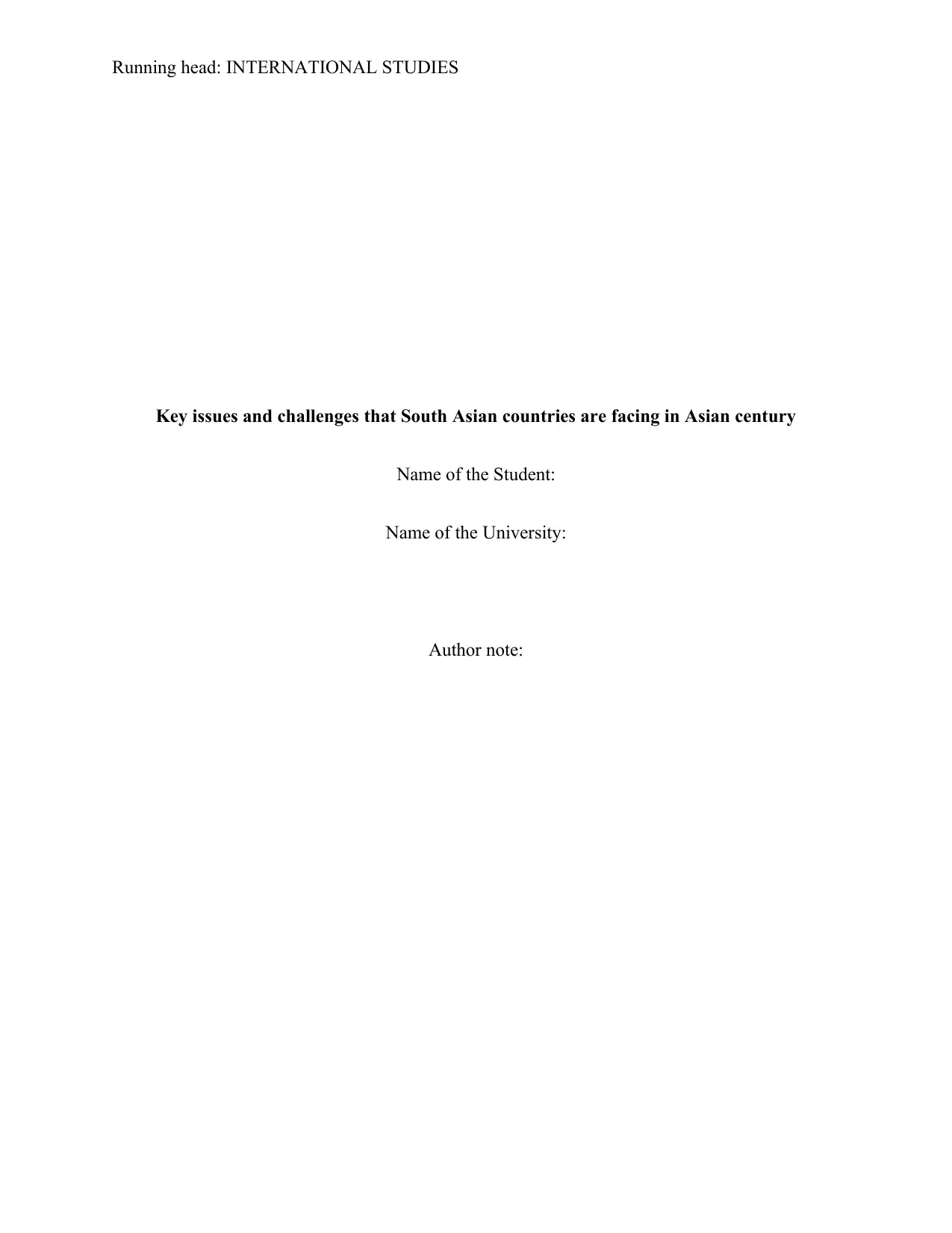
Running head: INTERNATIONAL STUDIES
Key issues and challenges that South Asian countries are facing in Asian century
Name of the Student:
Name of the University:
Author note:
Key issues and challenges that South Asian countries are facing in Asian century
Name of the Student:
Name of the University:
Author note:
Secure Best Marks with AI Grader
Need help grading? Try our AI Grader for instant feedback on your assignments.
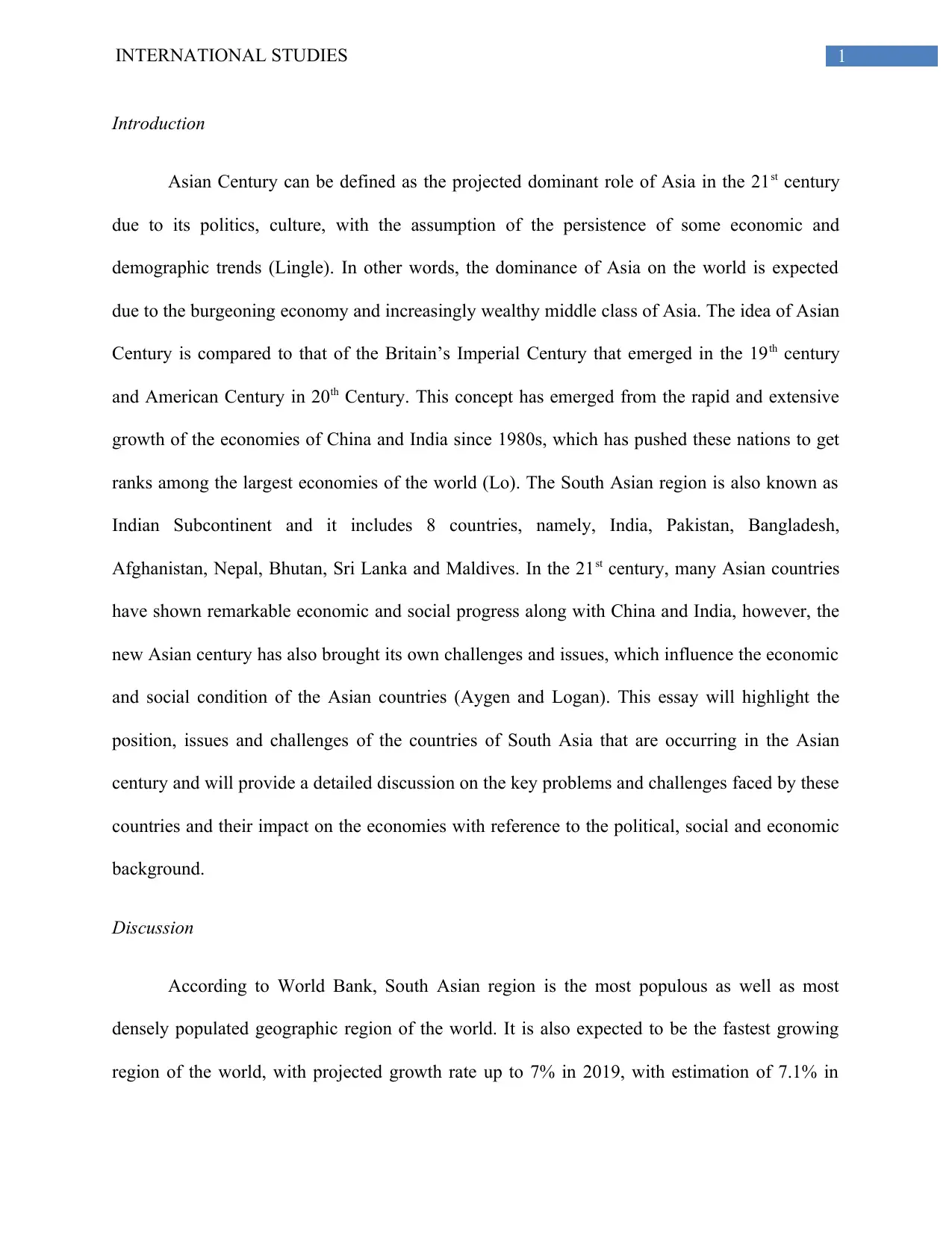
1INTERNATIONAL STUDIES
Introduction
Asian Century can be defined as the projected dominant role of Asia in the 21st century
due to its politics, culture, with the assumption of the persistence of some economic and
demographic trends (Lingle). In other words, the dominance of Asia on the world is expected
due to the burgeoning economy and increasingly wealthy middle class of Asia. The idea of Asian
Century is compared to that of the Britain’s Imperial Century that emerged in the 19th century
and American Century in 20th Century. This concept has emerged from the rapid and extensive
growth of the economies of China and India since 1980s, which has pushed these nations to get
ranks among the largest economies of the world (Lo). The South Asian region is also known as
Indian Subcontinent and it includes 8 countries, namely, India, Pakistan, Bangladesh,
Afghanistan, Nepal, Bhutan, Sri Lanka and Maldives. In the 21st century, many Asian countries
have shown remarkable economic and social progress along with China and India, however, the
new Asian century has also brought its own challenges and issues, which influence the economic
and social condition of the Asian countries (Aygen and Logan). This essay will highlight the
position, issues and challenges of the countries of South Asia that are occurring in the Asian
century and will provide a detailed discussion on the key problems and challenges faced by these
countries and their impact on the economies with reference to the political, social and economic
background.
Discussion
According to World Bank, South Asian region is the most populous as well as most
densely populated geographic region of the world. It is also expected to be the fastest growing
region of the world, with projected growth rate up to 7% in 2019, with estimation of 7.1% in
Introduction
Asian Century can be defined as the projected dominant role of Asia in the 21st century
due to its politics, culture, with the assumption of the persistence of some economic and
demographic trends (Lingle). In other words, the dominance of Asia on the world is expected
due to the burgeoning economy and increasingly wealthy middle class of Asia. The idea of Asian
Century is compared to that of the Britain’s Imperial Century that emerged in the 19th century
and American Century in 20th Century. This concept has emerged from the rapid and extensive
growth of the economies of China and India since 1980s, which has pushed these nations to get
ranks among the largest economies of the world (Lo). The South Asian region is also known as
Indian Subcontinent and it includes 8 countries, namely, India, Pakistan, Bangladesh,
Afghanistan, Nepal, Bhutan, Sri Lanka and Maldives. In the 21st century, many Asian countries
have shown remarkable economic and social progress along with China and India, however, the
new Asian century has also brought its own challenges and issues, which influence the economic
and social condition of the Asian countries (Aygen and Logan). This essay will highlight the
position, issues and challenges of the countries of South Asia that are occurring in the Asian
century and will provide a detailed discussion on the key problems and challenges faced by these
countries and their impact on the economies with reference to the political, social and economic
background.
Discussion
According to World Bank, South Asian region is the most populous as well as most
densely populated geographic region of the world. It is also expected to be the fastest growing
region of the world, with projected growth rate up to 7% in 2019, with estimation of 7.1% in
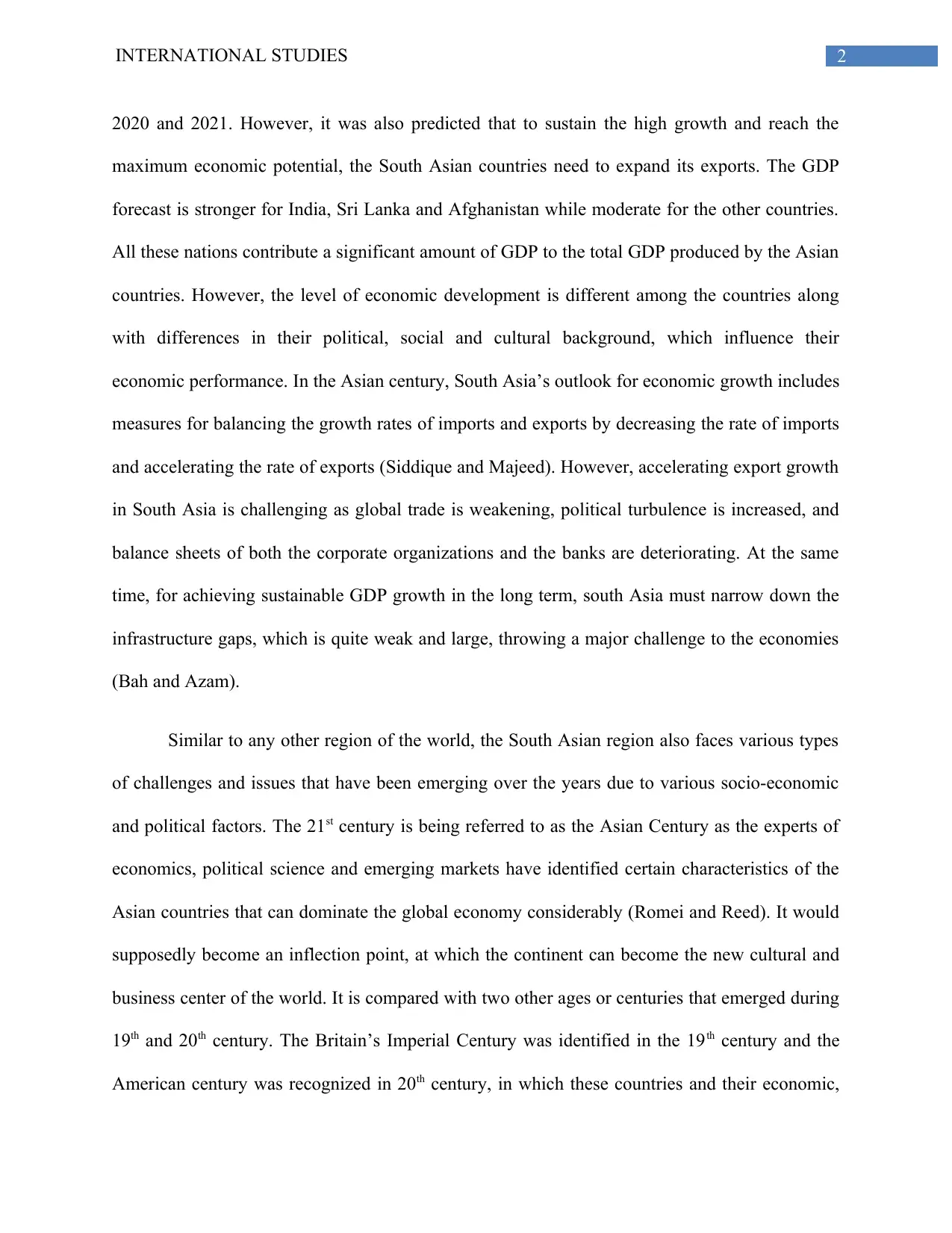
2INTERNATIONAL STUDIES
2020 and 2021. However, it was also predicted that to sustain the high growth and reach the
maximum economic potential, the South Asian countries need to expand its exports. The GDP
forecast is stronger for India, Sri Lanka and Afghanistan while moderate for the other countries.
All these nations contribute a significant amount of GDP to the total GDP produced by the Asian
countries. However, the level of economic development is different among the countries along
with differences in their political, social and cultural background, which influence their
economic performance. In the Asian century, South Asia’s outlook for economic growth includes
measures for balancing the growth rates of imports and exports by decreasing the rate of imports
and accelerating the rate of exports (Siddique and Majeed). However, accelerating export growth
in South Asia is challenging as global trade is weakening, political turbulence is increased, and
balance sheets of both the corporate organizations and the banks are deteriorating. At the same
time, for achieving sustainable GDP growth in the long term, south Asia must narrow down the
infrastructure gaps, which is quite weak and large, throwing a major challenge to the economies
(Bah and Azam).
Similar to any other region of the world, the South Asian region also faces various types
of challenges and issues that have been emerging over the years due to various socio-economic
and political factors. The 21st century is being referred to as the Asian Century as the experts of
economics, political science and emerging markets have identified certain characteristics of the
Asian countries that can dominate the global economy considerably (Romei and Reed). It would
supposedly become an inflection point, at which the continent can become the new cultural and
business center of the world. It is compared with two other ages or centuries that emerged during
19th and 20th century. The Britain’s Imperial Century was identified in the 19th century and the
American century was recognized in 20th century, in which these countries and their economic,
2020 and 2021. However, it was also predicted that to sustain the high growth and reach the
maximum economic potential, the South Asian countries need to expand its exports. The GDP
forecast is stronger for India, Sri Lanka and Afghanistan while moderate for the other countries.
All these nations contribute a significant amount of GDP to the total GDP produced by the Asian
countries. However, the level of economic development is different among the countries along
with differences in their political, social and cultural background, which influence their
economic performance. In the Asian century, South Asia’s outlook for economic growth includes
measures for balancing the growth rates of imports and exports by decreasing the rate of imports
and accelerating the rate of exports (Siddique and Majeed). However, accelerating export growth
in South Asia is challenging as global trade is weakening, political turbulence is increased, and
balance sheets of both the corporate organizations and the banks are deteriorating. At the same
time, for achieving sustainable GDP growth in the long term, south Asia must narrow down the
infrastructure gaps, which is quite weak and large, throwing a major challenge to the economies
(Bah and Azam).
Similar to any other region of the world, the South Asian region also faces various types
of challenges and issues that have been emerging over the years due to various socio-economic
and political factors. The 21st century is being referred to as the Asian Century as the experts of
economics, political science and emerging markets have identified certain characteristics of the
Asian countries that can dominate the global economy considerably (Romei and Reed). It would
supposedly become an inflection point, at which the continent can become the new cultural and
business center of the world. It is compared with two other ages or centuries that emerged during
19th and 20th century. The Britain’s Imperial Century was identified in the 19th century and the
American century was recognized in 20th century, in which these countries and their economic,
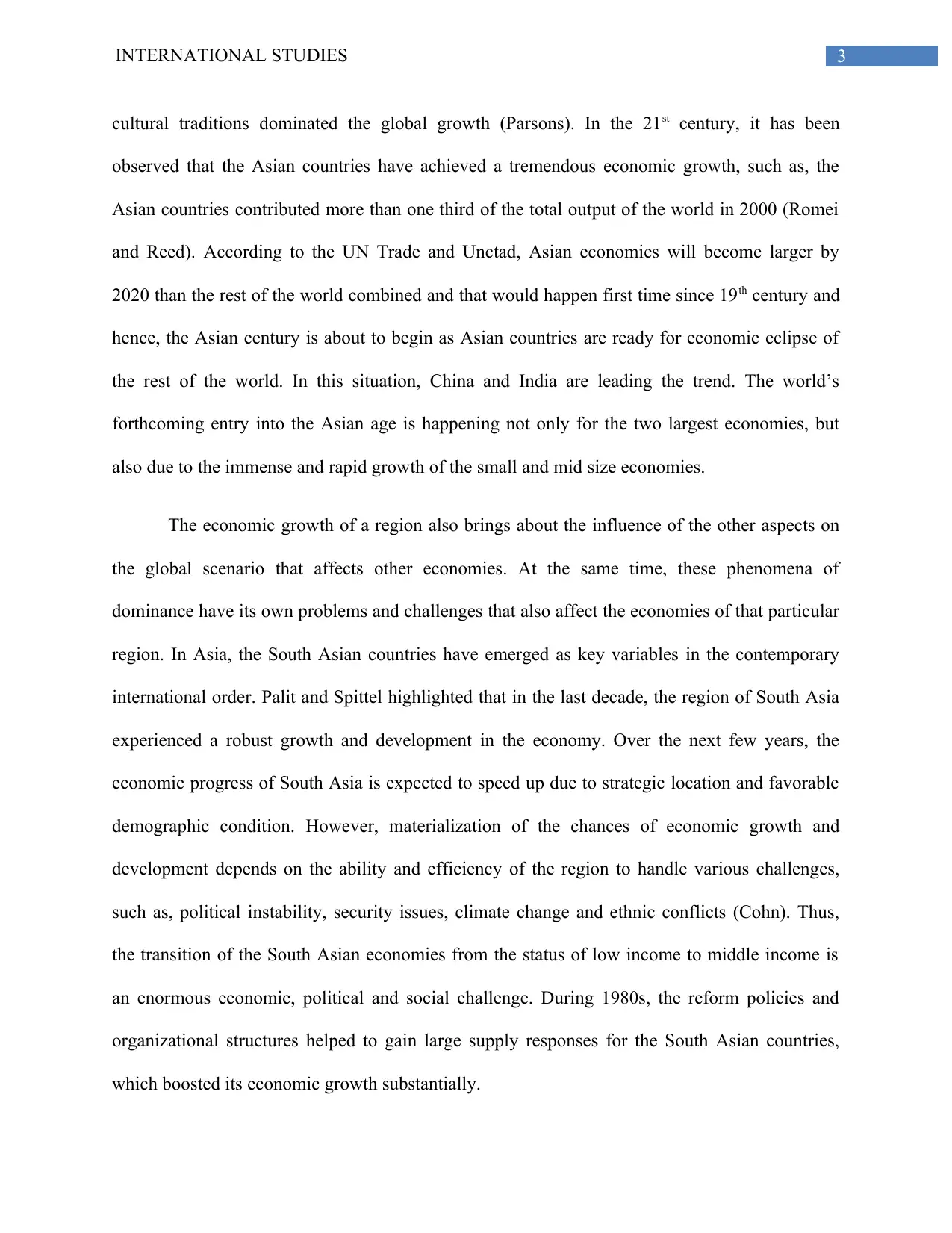
3INTERNATIONAL STUDIES
cultural traditions dominated the global growth (Parsons). In the 21st century, it has been
observed that the Asian countries have achieved a tremendous economic growth, such as, the
Asian countries contributed more than one third of the total output of the world in 2000 (Romei
and Reed). According to the UN Trade and Unctad, Asian economies will become larger by
2020 than the rest of the world combined and that would happen first time since 19th century and
hence, the Asian century is about to begin as Asian countries are ready for economic eclipse of
the rest of the world. In this situation, China and India are leading the trend. The world’s
forthcoming entry into the Asian age is happening not only for the two largest economies, but
also due to the immense and rapid growth of the small and mid size economies.
The economic growth of a region also brings about the influence of the other aspects on
the global scenario that affects other economies. At the same time, these phenomena of
dominance have its own problems and challenges that also affect the economies of that particular
region. In Asia, the South Asian countries have emerged as key variables in the contemporary
international order. Palit and Spittel highlighted that in the last decade, the region of South Asia
experienced a robust growth and development in the economy. Over the next few years, the
economic progress of South Asia is expected to speed up due to strategic location and favorable
demographic condition. However, materialization of the chances of economic growth and
development depends on the ability and efficiency of the region to handle various challenges,
such as, political instability, security issues, climate change and ethnic conflicts (Cohn). Thus,
the transition of the South Asian economies from the status of low income to middle income is
an enormous economic, political and social challenge. During 1980s, the reform policies and
organizational structures helped to gain large supply responses for the South Asian countries,
which boosted its economic growth substantially.
cultural traditions dominated the global growth (Parsons). In the 21st century, it has been
observed that the Asian countries have achieved a tremendous economic growth, such as, the
Asian countries contributed more than one third of the total output of the world in 2000 (Romei
and Reed). According to the UN Trade and Unctad, Asian economies will become larger by
2020 than the rest of the world combined and that would happen first time since 19th century and
hence, the Asian century is about to begin as Asian countries are ready for economic eclipse of
the rest of the world. In this situation, China and India are leading the trend. The world’s
forthcoming entry into the Asian age is happening not only for the two largest economies, but
also due to the immense and rapid growth of the small and mid size economies.
The economic growth of a region also brings about the influence of the other aspects on
the global scenario that affects other economies. At the same time, these phenomena of
dominance have its own problems and challenges that also affect the economies of that particular
region. In Asia, the South Asian countries have emerged as key variables in the contemporary
international order. Palit and Spittel highlighted that in the last decade, the region of South Asia
experienced a robust growth and development in the economy. Over the next few years, the
economic progress of South Asia is expected to speed up due to strategic location and favorable
demographic condition. However, materialization of the chances of economic growth and
development depends on the ability and efficiency of the region to handle various challenges,
such as, political instability, security issues, climate change and ethnic conflicts (Cohn). Thus,
the transition of the South Asian economies from the status of low income to middle income is
an enormous economic, political and social challenge. During 1980s, the reform policies and
organizational structures helped to gain large supply responses for the South Asian countries,
which boosted its economic growth substantially.
Secure Best Marks with AI Grader
Need help grading? Try our AI Grader for instant feedback on your assignments.
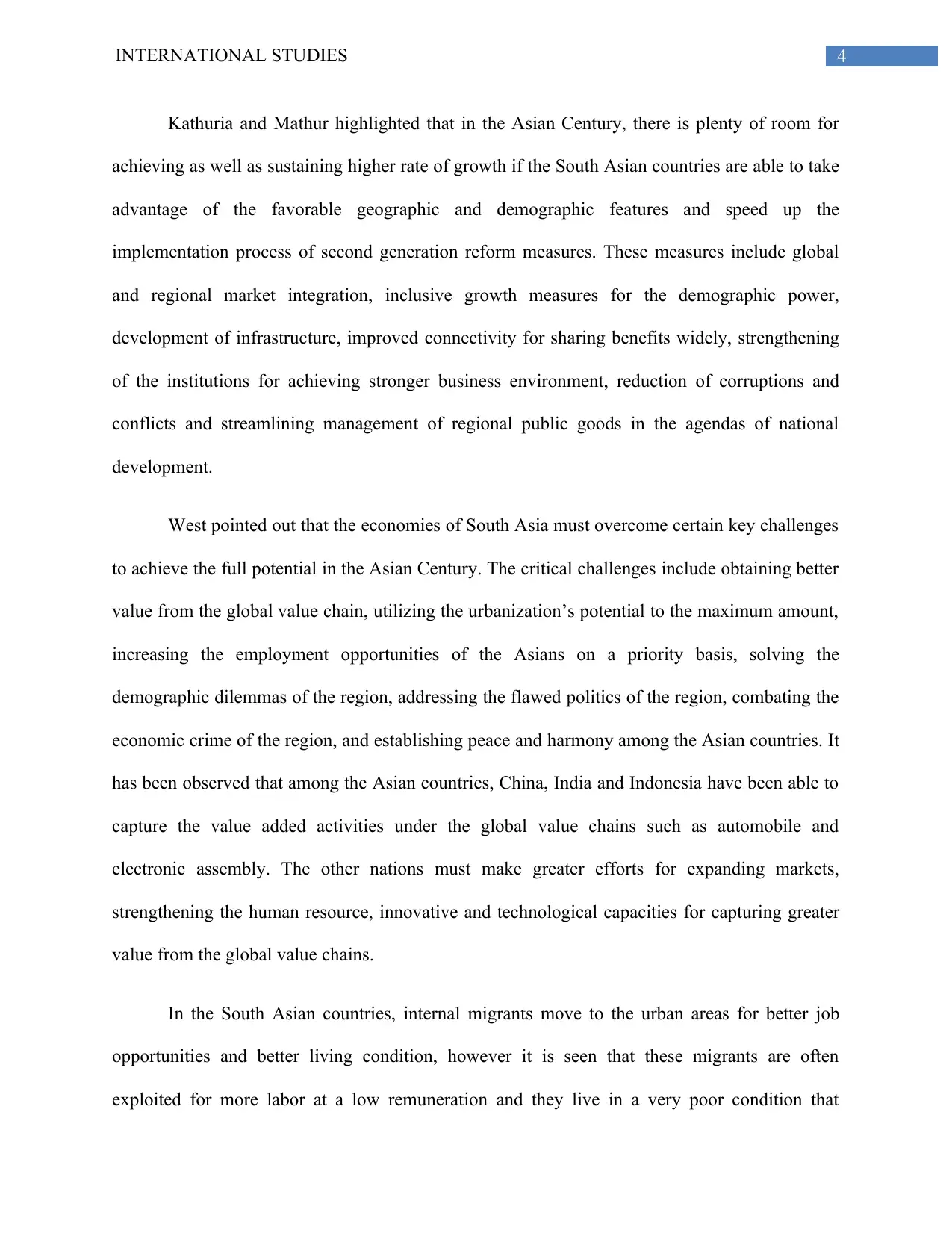
4INTERNATIONAL STUDIES
Kathuria and Mathur highlighted that in the Asian Century, there is plenty of room for
achieving as well as sustaining higher rate of growth if the South Asian countries are able to take
advantage of the favorable geographic and demographic features and speed up the
implementation process of second generation reform measures. These measures include global
and regional market integration, inclusive growth measures for the demographic power,
development of infrastructure, improved connectivity for sharing benefits widely, strengthening
of the institutions for achieving stronger business environment, reduction of corruptions and
conflicts and streamlining management of regional public goods in the agendas of national
development.
West pointed out that the economies of South Asia must overcome certain key challenges
to achieve the full potential in the Asian Century. The critical challenges include obtaining better
value from the global value chain, utilizing the urbanization’s potential to the maximum amount,
increasing the employment opportunities of the Asians on a priority basis, solving the
demographic dilemmas of the region, addressing the flawed politics of the region, combating the
economic crime of the region, and establishing peace and harmony among the Asian countries. It
has been observed that among the Asian countries, China, India and Indonesia have been able to
capture the value added activities under the global value chains such as automobile and
electronic assembly. The other nations must make greater efforts for expanding markets,
strengthening the human resource, innovative and technological capacities for capturing greater
value from the global value chains.
In the South Asian countries, internal migrants move to the urban areas for better job
opportunities and better living condition, however it is seen that these migrants are often
exploited for more labor at a low remuneration and they live in a very poor condition that
Kathuria and Mathur highlighted that in the Asian Century, there is plenty of room for
achieving as well as sustaining higher rate of growth if the South Asian countries are able to take
advantage of the favorable geographic and demographic features and speed up the
implementation process of second generation reform measures. These measures include global
and regional market integration, inclusive growth measures for the demographic power,
development of infrastructure, improved connectivity for sharing benefits widely, strengthening
of the institutions for achieving stronger business environment, reduction of corruptions and
conflicts and streamlining management of regional public goods in the agendas of national
development.
West pointed out that the economies of South Asia must overcome certain key challenges
to achieve the full potential in the Asian Century. The critical challenges include obtaining better
value from the global value chain, utilizing the urbanization’s potential to the maximum amount,
increasing the employment opportunities of the Asians on a priority basis, solving the
demographic dilemmas of the region, addressing the flawed politics of the region, combating the
economic crime of the region, and establishing peace and harmony among the Asian countries. It
has been observed that among the Asian countries, China, India and Indonesia have been able to
capture the value added activities under the global value chains such as automobile and
electronic assembly. The other nations must make greater efforts for expanding markets,
strengthening the human resource, innovative and technological capacities for capturing greater
value from the global value chains.
In the South Asian countries, internal migrants move to the urban areas for better job
opportunities and better living condition, however it is seen that these migrants are often
exploited for more labor at a low remuneration and they live in a very poor condition that
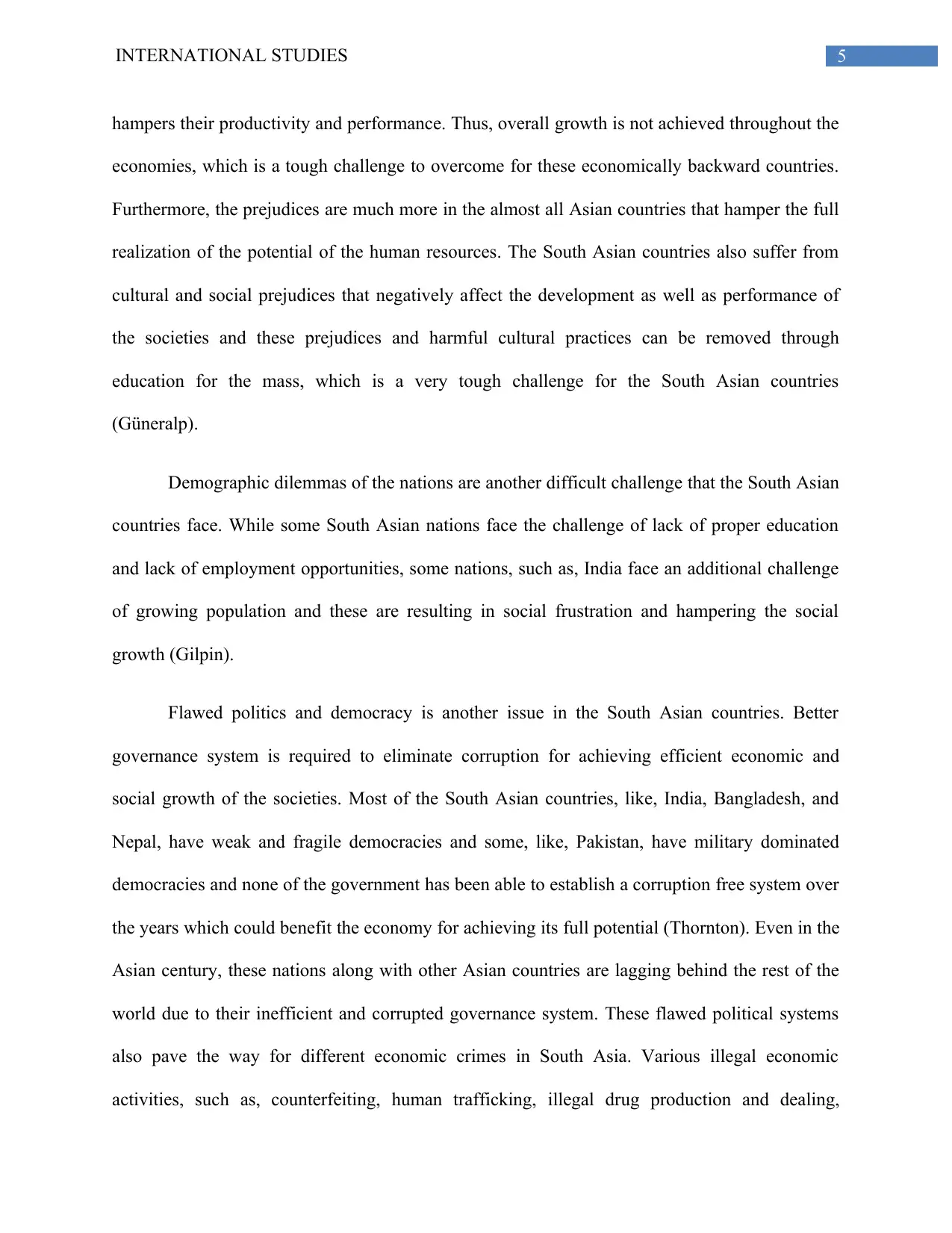
5INTERNATIONAL STUDIES
hampers their productivity and performance. Thus, overall growth is not achieved throughout the
economies, which is a tough challenge to overcome for these economically backward countries.
Furthermore, the prejudices are much more in the almost all Asian countries that hamper the full
realization of the potential of the human resources. The South Asian countries also suffer from
cultural and social prejudices that negatively affect the development as well as performance of
the societies and these prejudices and harmful cultural practices can be removed through
education for the mass, which is a very tough challenge for the South Asian countries
(Güneralp).
Demographic dilemmas of the nations are another difficult challenge that the South Asian
countries face. While some South Asian nations face the challenge of lack of proper education
and lack of employment opportunities, some nations, such as, India face an additional challenge
of growing population and these are resulting in social frustration and hampering the social
growth (Gilpin).
Flawed politics and democracy is another issue in the South Asian countries. Better
governance system is required to eliminate corruption for achieving efficient economic and
social growth of the societies. Most of the South Asian countries, like, India, Bangladesh, and
Nepal, have weak and fragile democracies and some, like, Pakistan, have military dominated
democracies and none of the government has been able to establish a corruption free system over
the years which could benefit the economy for achieving its full potential (Thornton). Even in the
Asian century, these nations along with other Asian countries are lagging behind the rest of the
world due to their inefficient and corrupted governance system. These flawed political systems
also pave the way for different economic crimes in South Asia. Various illegal economic
activities, such as, counterfeiting, human trafficking, illegal drug production and dealing,
hampers their productivity and performance. Thus, overall growth is not achieved throughout the
economies, which is a tough challenge to overcome for these economically backward countries.
Furthermore, the prejudices are much more in the almost all Asian countries that hamper the full
realization of the potential of the human resources. The South Asian countries also suffer from
cultural and social prejudices that negatively affect the development as well as performance of
the societies and these prejudices and harmful cultural practices can be removed through
education for the mass, which is a very tough challenge for the South Asian countries
(Güneralp).
Demographic dilemmas of the nations are another difficult challenge that the South Asian
countries face. While some South Asian nations face the challenge of lack of proper education
and lack of employment opportunities, some nations, such as, India face an additional challenge
of growing population and these are resulting in social frustration and hampering the social
growth (Gilpin).
Flawed politics and democracy is another issue in the South Asian countries. Better
governance system is required to eliminate corruption for achieving efficient economic and
social growth of the societies. Most of the South Asian countries, like, India, Bangladesh, and
Nepal, have weak and fragile democracies and some, like, Pakistan, have military dominated
democracies and none of the government has been able to establish a corruption free system over
the years which could benefit the economy for achieving its full potential (Thornton). Even in the
Asian century, these nations along with other Asian countries are lagging behind the rest of the
world due to their inefficient and corrupted governance system. These flawed political systems
also pave the way for different economic crimes in South Asia. Various illegal economic
activities, such as, counterfeiting, human trafficking, illegal drug production and dealing,
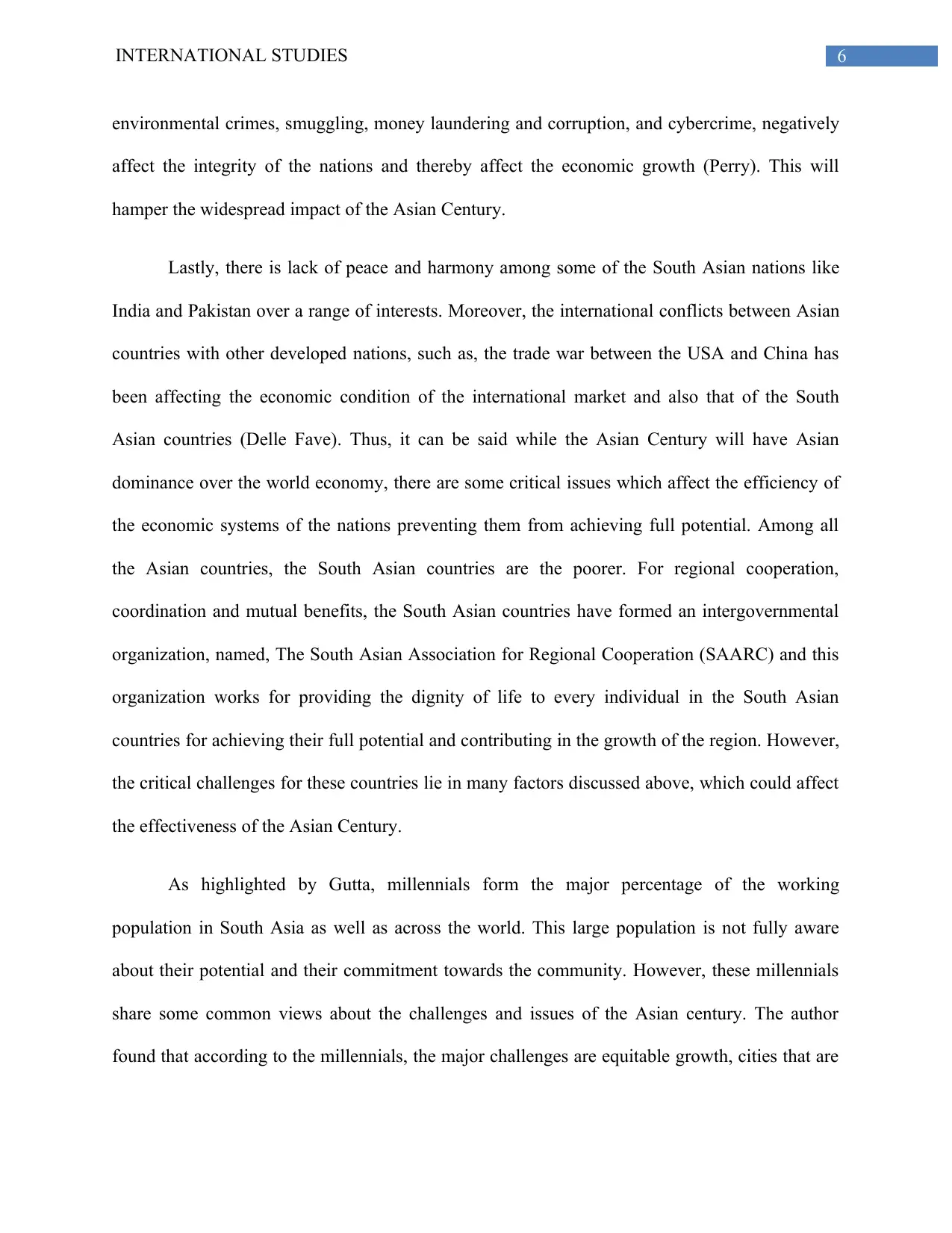
6INTERNATIONAL STUDIES
environmental crimes, smuggling, money laundering and corruption, and cybercrime, negatively
affect the integrity of the nations and thereby affect the economic growth (Perry). This will
hamper the widespread impact of the Asian Century.
Lastly, there is lack of peace and harmony among some of the South Asian nations like
India and Pakistan over a range of interests. Moreover, the international conflicts between Asian
countries with other developed nations, such as, the trade war between the USA and China has
been affecting the economic condition of the international market and also that of the South
Asian countries (Delle Fave). Thus, it can be said while the Asian Century will have Asian
dominance over the world economy, there are some critical issues which affect the efficiency of
the economic systems of the nations preventing them from achieving full potential. Among all
the Asian countries, the South Asian countries are the poorer. For regional cooperation,
coordination and mutual benefits, the South Asian countries have formed an intergovernmental
organization, named, The South Asian Association for Regional Cooperation (SAARC) and this
organization works for providing the dignity of life to every individual in the South Asian
countries for achieving their full potential and contributing in the growth of the region. However,
the critical challenges for these countries lie in many factors discussed above, which could affect
the effectiveness of the Asian Century.
As highlighted by Gutta, millennials form the major percentage of the working
population in South Asia as well as across the world. This large population is not fully aware
about their potential and their commitment towards the community. However, these millennials
share some common views about the challenges and issues of the Asian century. The author
found that according to the millennials, the major challenges are equitable growth, cities that are
environmental crimes, smuggling, money laundering and corruption, and cybercrime, negatively
affect the integrity of the nations and thereby affect the economic growth (Perry). This will
hamper the widespread impact of the Asian Century.
Lastly, there is lack of peace and harmony among some of the South Asian nations like
India and Pakistan over a range of interests. Moreover, the international conflicts between Asian
countries with other developed nations, such as, the trade war between the USA and China has
been affecting the economic condition of the international market and also that of the South
Asian countries (Delle Fave). Thus, it can be said while the Asian Century will have Asian
dominance over the world economy, there are some critical issues which affect the efficiency of
the economic systems of the nations preventing them from achieving full potential. Among all
the Asian countries, the South Asian countries are the poorer. For regional cooperation,
coordination and mutual benefits, the South Asian countries have formed an intergovernmental
organization, named, The South Asian Association for Regional Cooperation (SAARC) and this
organization works for providing the dignity of life to every individual in the South Asian
countries for achieving their full potential and contributing in the growth of the region. However,
the critical challenges for these countries lie in many factors discussed above, which could affect
the effectiveness of the Asian Century.
As highlighted by Gutta, millennials form the major percentage of the working
population in South Asia as well as across the world. This large population is not fully aware
about their potential and their commitment towards the community. However, these millennials
share some common views about the challenges and issues of the Asian century. The author
found that according to the millennials, the major challenges are equitable growth, cities that are
Paraphrase This Document
Need a fresh take? Get an instant paraphrase of this document with our AI Paraphraser
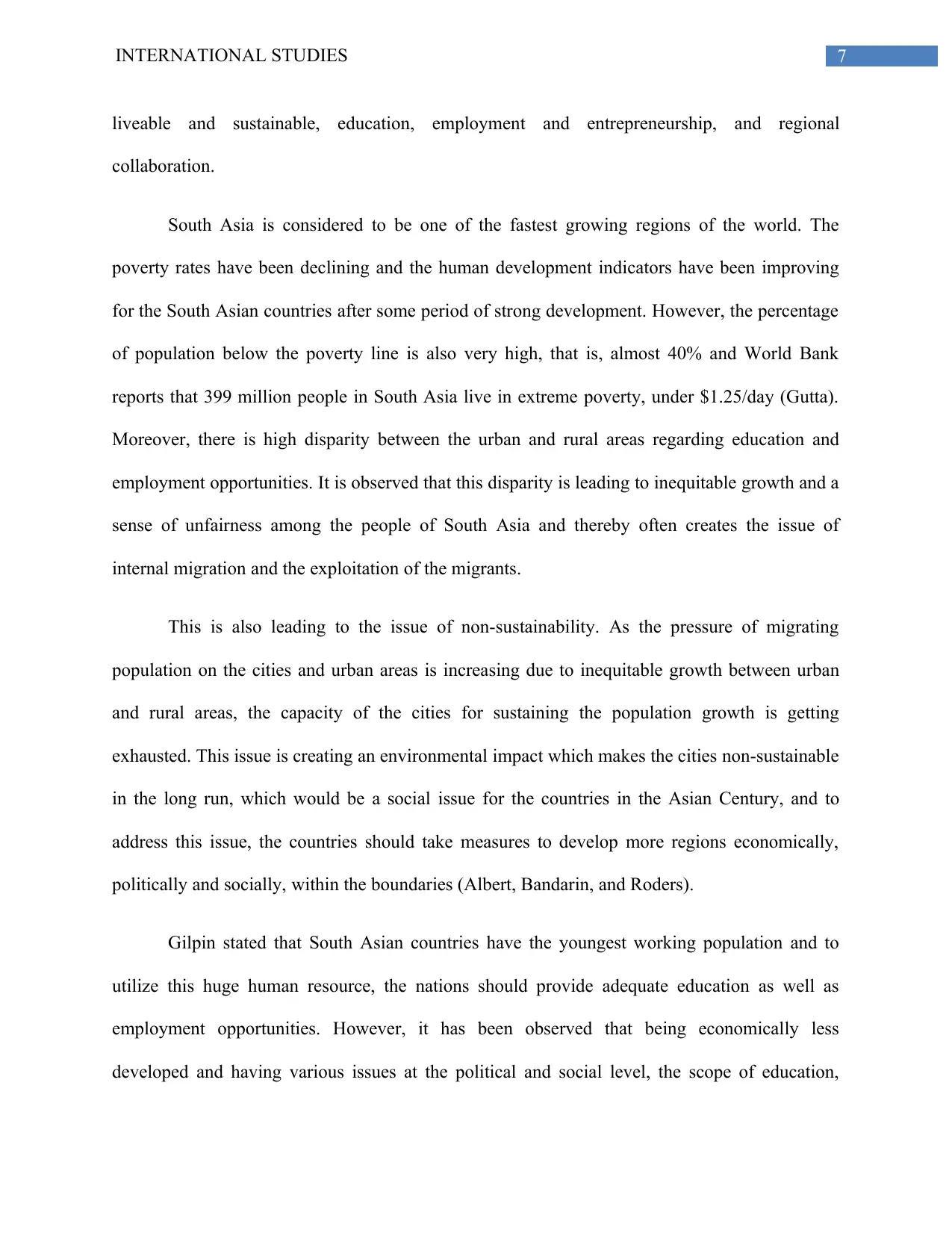
7INTERNATIONAL STUDIES
liveable and sustainable, education, employment and entrepreneurship, and regional
collaboration.
South Asia is considered to be one of the fastest growing regions of the world. The
poverty rates have been declining and the human development indicators have been improving
for the South Asian countries after some period of strong development. However, the percentage
of population below the poverty line is also very high, that is, almost 40% and World Bank
reports that 399 million people in South Asia live in extreme poverty, under $1.25/day (Gutta).
Moreover, there is high disparity between the urban and rural areas regarding education and
employment opportunities. It is observed that this disparity is leading to inequitable growth and a
sense of unfairness among the people of South Asia and thereby often creates the issue of
internal migration and the exploitation of the migrants.
This is also leading to the issue of non-sustainability. As the pressure of migrating
population on the cities and urban areas is increasing due to inequitable growth between urban
and rural areas, the capacity of the cities for sustaining the population growth is getting
exhausted. This issue is creating an environmental impact which makes the cities non-sustainable
in the long run, which would be a social issue for the countries in the Asian Century, and to
address this issue, the countries should take measures to develop more regions economically,
politically and socially, within the boundaries (Albert, Bandarin, and Roders).
Gilpin stated that South Asian countries have the youngest working population and to
utilize this huge human resource, the nations should provide adequate education as well as
employment opportunities. However, it has been observed that being economically less
developed and having various issues at the political and social level, the scope of education,
liveable and sustainable, education, employment and entrepreneurship, and regional
collaboration.
South Asia is considered to be one of the fastest growing regions of the world. The
poverty rates have been declining and the human development indicators have been improving
for the South Asian countries after some period of strong development. However, the percentage
of population below the poverty line is also very high, that is, almost 40% and World Bank
reports that 399 million people in South Asia live in extreme poverty, under $1.25/day (Gutta).
Moreover, there is high disparity between the urban and rural areas regarding education and
employment opportunities. It is observed that this disparity is leading to inequitable growth and a
sense of unfairness among the people of South Asia and thereby often creates the issue of
internal migration and the exploitation of the migrants.
This is also leading to the issue of non-sustainability. As the pressure of migrating
population on the cities and urban areas is increasing due to inequitable growth between urban
and rural areas, the capacity of the cities for sustaining the population growth is getting
exhausted. This issue is creating an environmental impact which makes the cities non-sustainable
in the long run, which would be a social issue for the countries in the Asian Century, and to
address this issue, the countries should take measures to develop more regions economically,
politically and socially, within the boundaries (Albert, Bandarin, and Roders).
Gilpin stated that South Asian countries have the youngest working population and to
utilize this huge human resource, the nations should provide adequate education as well as
employment opportunities. However, it has been observed that being economically less
developed and having various issues at the political and social level, the scope of education,
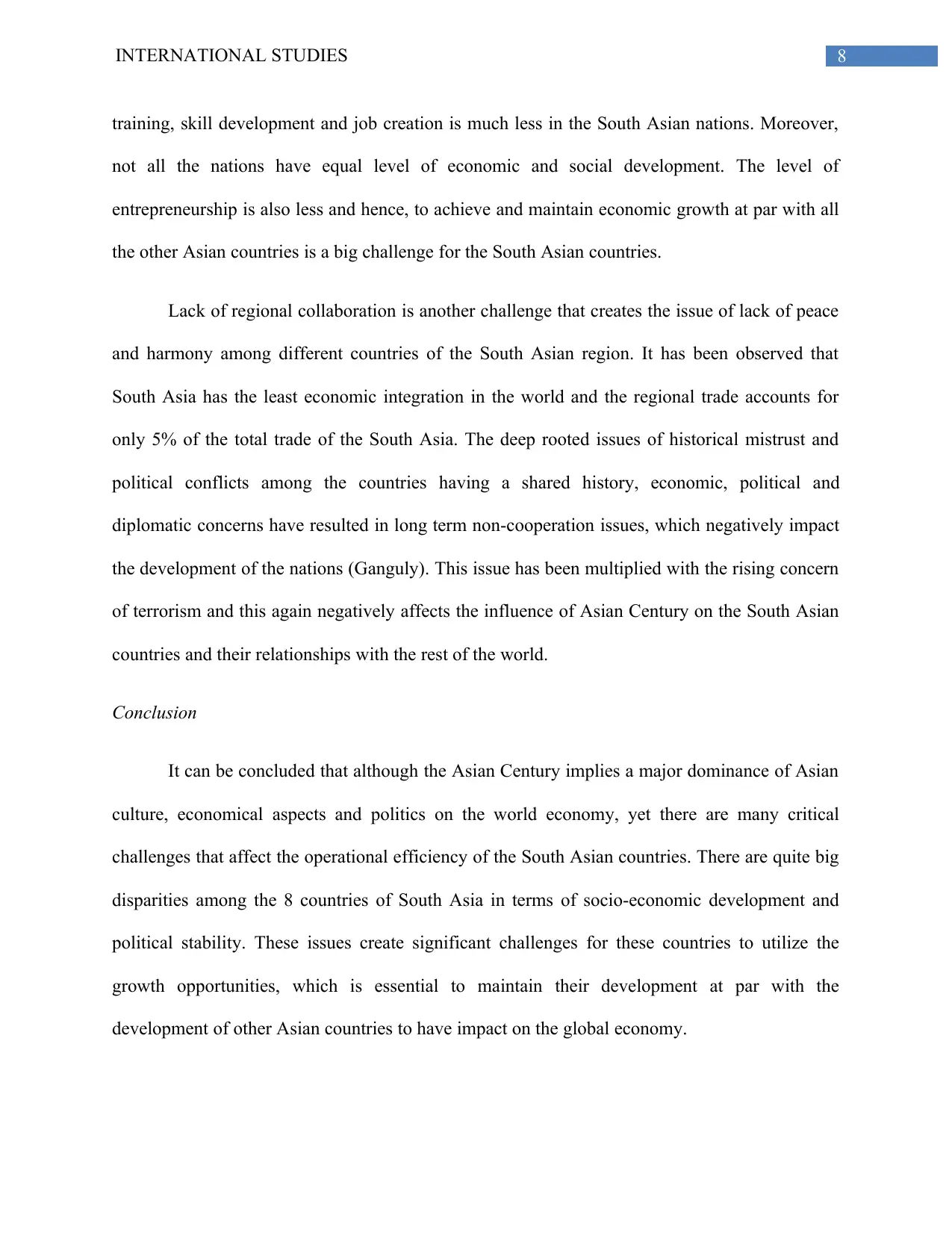
8INTERNATIONAL STUDIES
training, skill development and job creation is much less in the South Asian nations. Moreover,
not all the nations have equal level of economic and social development. The level of
entrepreneurship is also less and hence, to achieve and maintain economic growth at par with all
the other Asian countries is a big challenge for the South Asian countries.
Lack of regional collaboration is another challenge that creates the issue of lack of peace
and harmony among different countries of the South Asian region. It has been observed that
South Asia has the least economic integration in the world and the regional trade accounts for
only 5% of the total trade of the South Asia. The deep rooted issues of historical mistrust and
political conflicts among the countries having a shared history, economic, political and
diplomatic concerns have resulted in long term non-cooperation issues, which negatively impact
the development of the nations (Ganguly). This issue has been multiplied with the rising concern
of terrorism and this again negatively affects the influence of Asian Century on the South Asian
countries and their relationships with the rest of the world.
Conclusion
It can be concluded that although the Asian Century implies a major dominance of Asian
culture, economical aspects and politics on the world economy, yet there are many critical
challenges that affect the operational efficiency of the South Asian countries. There are quite big
disparities among the 8 countries of South Asia in terms of socio-economic development and
political stability. These issues create significant challenges for these countries to utilize the
growth opportunities, which is essential to maintain their development at par with the
development of other Asian countries to have impact on the global economy.
training, skill development and job creation is much less in the South Asian nations. Moreover,
not all the nations have equal level of economic and social development. The level of
entrepreneurship is also less and hence, to achieve and maintain economic growth at par with all
the other Asian countries is a big challenge for the South Asian countries.
Lack of regional collaboration is another challenge that creates the issue of lack of peace
and harmony among different countries of the South Asian region. It has been observed that
South Asia has the least economic integration in the world and the regional trade accounts for
only 5% of the total trade of the South Asia. The deep rooted issues of historical mistrust and
political conflicts among the countries having a shared history, economic, political and
diplomatic concerns have resulted in long term non-cooperation issues, which negatively impact
the development of the nations (Ganguly). This issue has been multiplied with the rising concern
of terrorism and this again negatively affects the influence of Asian Century on the South Asian
countries and their relationships with the rest of the world.
Conclusion
It can be concluded that although the Asian Century implies a major dominance of Asian
culture, economical aspects and politics on the world economy, yet there are many critical
challenges that affect the operational efficiency of the South Asian countries. There are quite big
disparities among the 8 countries of South Asia in terms of socio-economic development and
political stability. These issues create significant challenges for these countries to utilize the
growth opportunities, which is essential to maintain their development at par with the
development of other Asian countries to have impact on the global economy.
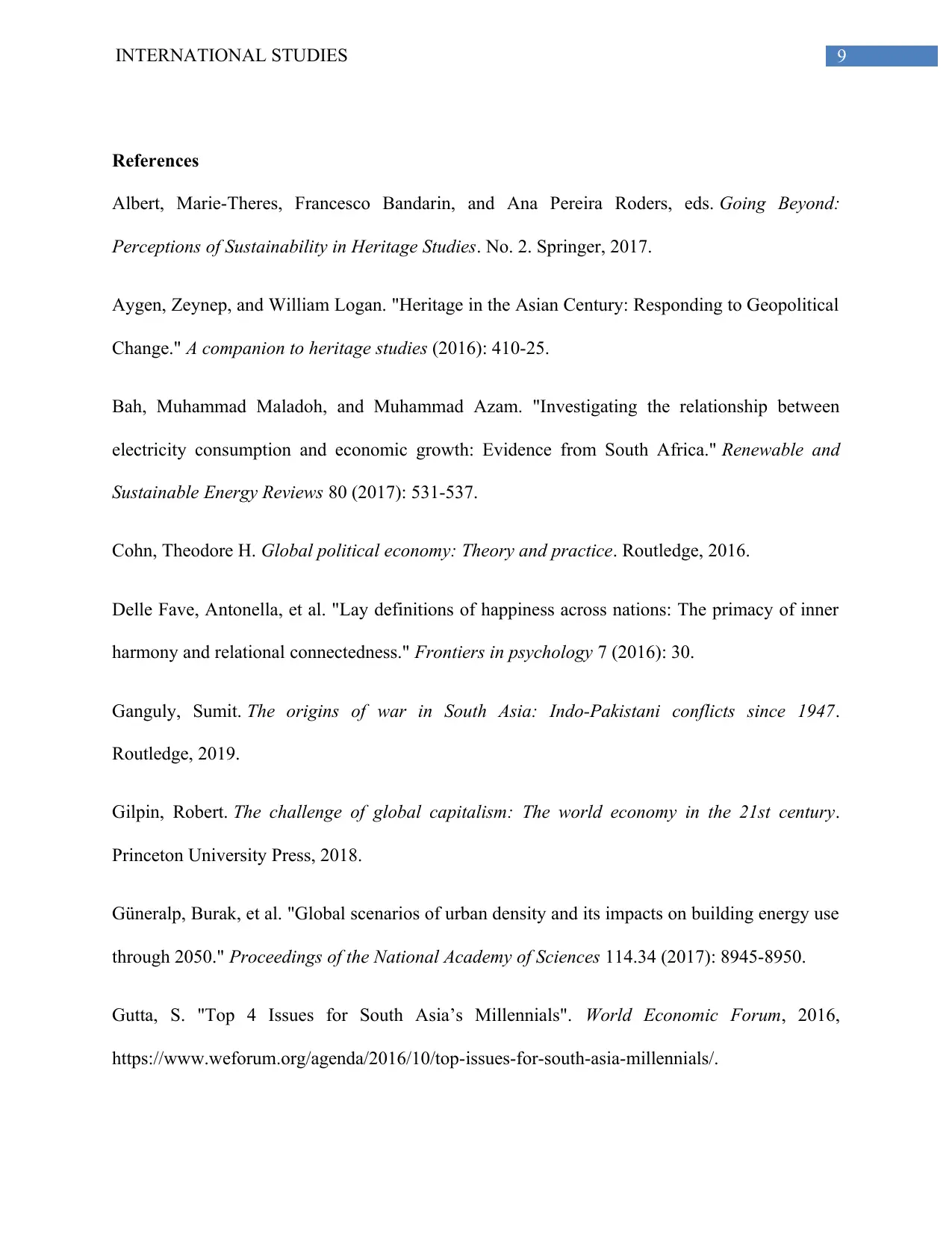
9INTERNATIONAL STUDIES
References
Albert, Marie-Theres, Francesco Bandarin, and Ana Pereira Roders, eds. Going Beyond:
Perceptions of Sustainability in Heritage Studies. No. 2. Springer, 2017.
Aygen, Zeynep, and William Logan. "Heritage in the Asian Century: Responding to Geopolitical
Change." A companion to heritage studies (2016): 410-25.
Bah, Muhammad Maladoh, and Muhammad Azam. "Investigating the relationship between
electricity consumption and economic growth: Evidence from South Africa." Renewable and
Sustainable Energy Reviews 80 (2017): 531-537.
Cohn, Theodore H. Global political economy: Theory and practice. Routledge, 2016.
Delle Fave, Antonella, et al. "Lay definitions of happiness across nations: The primacy of inner
harmony and relational connectedness." Frontiers in psychology 7 (2016): 30.
Ganguly, Sumit. The origins of war in South Asia: Indo-Pakistani conflicts since 1947.
Routledge, 2019.
Gilpin, Robert. The challenge of global capitalism: The world economy in the 21st century.
Princeton University Press, 2018.
Güneralp, Burak, et al. "Global scenarios of urban density and its impacts on building energy use
through 2050." Proceedings of the National Academy of Sciences 114.34 (2017): 8945-8950.
Gutta, S. "Top 4 Issues for South Asia’s Millennials". World Economic Forum, 2016,
https://www.weforum.org/agenda/2016/10/top-issues-for-south-asia-millennials/.
References
Albert, Marie-Theres, Francesco Bandarin, and Ana Pereira Roders, eds. Going Beyond:
Perceptions of Sustainability in Heritage Studies. No. 2. Springer, 2017.
Aygen, Zeynep, and William Logan. "Heritage in the Asian Century: Responding to Geopolitical
Change." A companion to heritage studies (2016): 410-25.
Bah, Muhammad Maladoh, and Muhammad Azam. "Investigating the relationship between
electricity consumption and economic growth: Evidence from South Africa." Renewable and
Sustainable Energy Reviews 80 (2017): 531-537.
Cohn, Theodore H. Global political economy: Theory and practice. Routledge, 2016.
Delle Fave, Antonella, et al. "Lay definitions of happiness across nations: The primacy of inner
harmony and relational connectedness." Frontiers in psychology 7 (2016): 30.
Ganguly, Sumit. The origins of war in South Asia: Indo-Pakistani conflicts since 1947.
Routledge, 2019.
Gilpin, Robert. The challenge of global capitalism: The world economy in the 21st century.
Princeton University Press, 2018.
Güneralp, Burak, et al. "Global scenarios of urban density and its impacts on building energy use
through 2050." Proceedings of the National Academy of Sciences 114.34 (2017): 8945-8950.
Gutta, S. "Top 4 Issues for South Asia’s Millennials". World Economic Forum, 2016,
https://www.weforum.org/agenda/2016/10/top-issues-for-south-asia-millennials/.
Secure Best Marks with AI Grader
Need help grading? Try our AI Grader for instant feedback on your assignments.
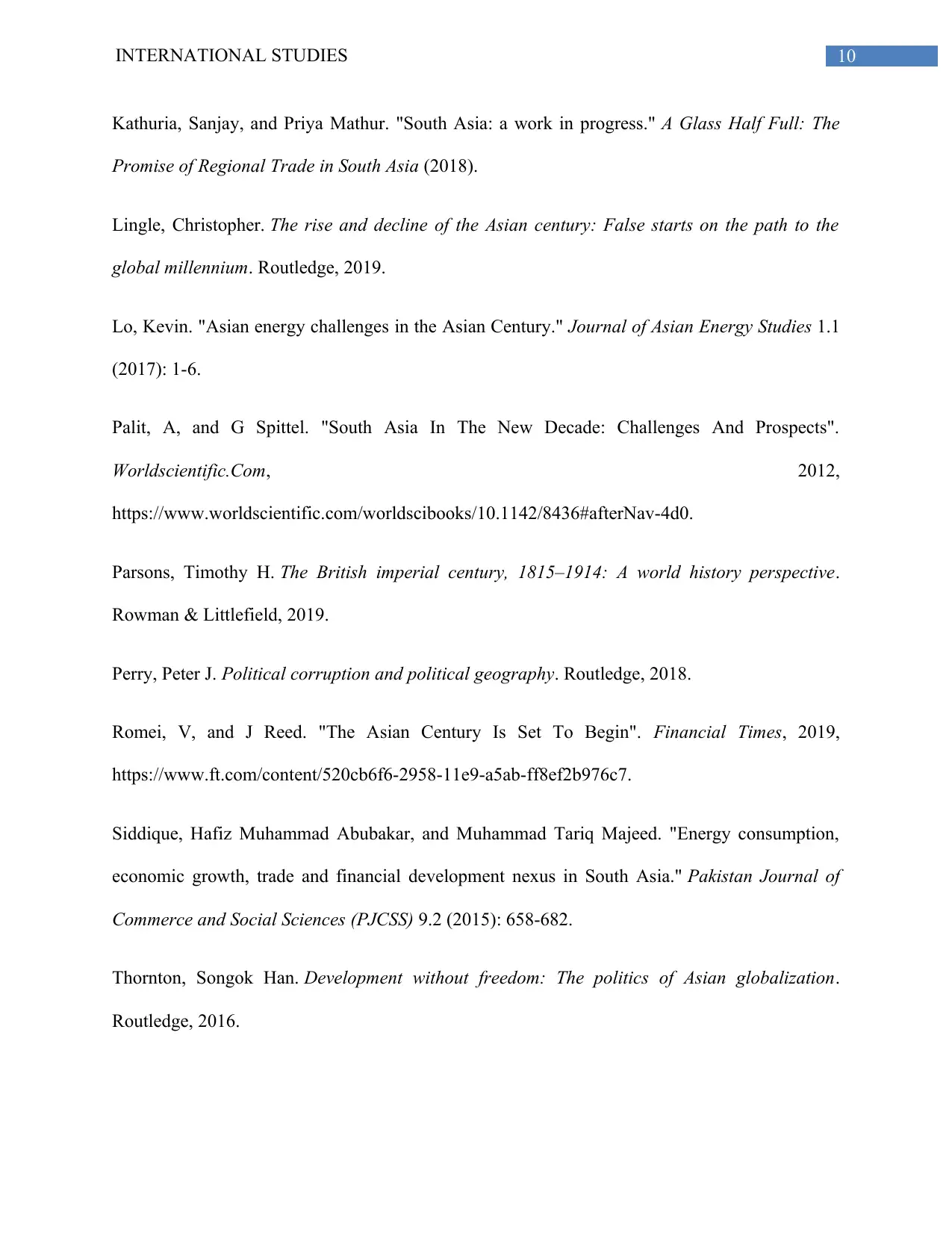
10INTERNATIONAL STUDIES
Kathuria, Sanjay, and Priya Mathur. "South Asia: a work in progress." A Glass Half Full: The
Promise of Regional Trade in South Asia (2018).
Lingle, Christopher. The rise and decline of the Asian century: False starts on the path to the
global millennium. Routledge, 2019.
Lo, Kevin. "Asian energy challenges in the Asian Century." Journal of Asian Energy Studies 1.1
(2017): 1-6.
Palit, A, and G Spittel. "South Asia In The New Decade: Challenges And Prospects".
Worldscientific.Com, 2012,
https://www.worldscientific.com/worldscibooks/10.1142/8436#afterNav-4d0.
Parsons, Timothy H. The British imperial century, 1815–1914: A world history perspective.
Rowman & Littlefield, 2019.
Perry, Peter J. Political corruption and political geography. Routledge, 2018.
Romei, V, and J Reed. "The Asian Century Is Set To Begin". Financial Times, 2019,
https://www.ft.com/content/520cb6f6-2958-11e9-a5ab-ff8ef2b976c7.
Siddique, Hafiz Muhammad Abubakar, and Muhammad Tariq Majeed. "Energy consumption,
economic growth, trade and financial development nexus in South Asia." Pakistan Journal of
Commerce and Social Sciences (PJCSS) 9.2 (2015): 658-682.
Thornton, Songok Han. Development without freedom: The politics of Asian globalization.
Routledge, 2016.
Kathuria, Sanjay, and Priya Mathur. "South Asia: a work in progress." A Glass Half Full: The
Promise of Regional Trade in South Asia (2018).
Lingle, Christopher. The rise and decline of the Asian century: False starts on the path to the
global millennium. Routledge, 2019.
Lo, Kevin. "Asian energy challenges in the Asian Century." Journal of Asian Energy Studies 1.1
(2017): 1-6.
Palit, A, and G Spittel. "South Asia In The New Decade: Challenges And Prospects".
Worldscientific.Com, 2012,
https://www.worldscientific.com/worldscibooks/10.1142/8436#afterNav-4d0.
Parsons, Timothy H. The British imperial century, 1815–1914: A world history perspective.
Rowman & Littlefield, 2019.
Perry, Peter J. Political corruption and political geography. Routledge, 2018.
Romei, V, and J Reed. "The Asian Century Is Set To Begin". Financial Times, 2019,
https://www.ft.com/content/520cb6f6-2958-11e9-a5ab-ff8ef2b976c7.
Siddique, Hafiz Muhammad Abubakar, and Muhammad Tariq Majeed. "Energy consumption,
economic growth, trade and financial development nexus in South Asia." Pakistan Journal of
Commerce and Social Sciences (PJCSS) 9.2 (2015): 658-682.
Thornton, Songok Han. Development without freedom: The politics of Asian globalization.
Routledge, 2016.

11INTERNATIONAL STUDIES
West, John. "Seven Challenges for An Asian Century". The Globalist, 2018,
https://www.theglobalist.com/asia-china-democracy-corruption-population/.
World Bank. "South Asia Overview". World Bank, 2019,
https://www.worldbank.org/en/region/sar/overview.
West, John. "Seven Challenges for An Asian Century". The Globalist, 2018,
https://www.theglobalist.com/asia-china-democracy-corruption-population/.
World Bank. "South Asia Overview". World Bank, 2019,
https://www.worldbank.org/en/region/sar/overview.
1 out of 12
Related Documents
Your All-in-One AI-Powered Toolkit for Academic Success.
+13062052269
info@desklib.com
Available 24*7 on WhatsApp / Email
![[object Object]](/_next/static/media/star-bottom.7253800d.svg)
Unlock your academic potential
© 2024 | Zucol Services PVT LTD | All rights reserved.





